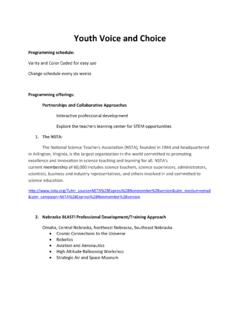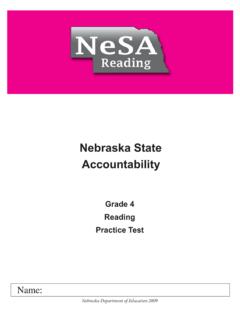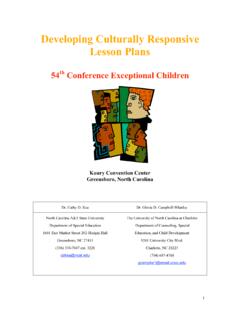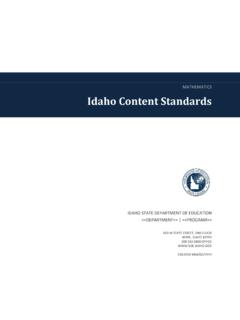Transcription of NEBRASKA MATHEMATICS STANDARDS
1 PROBLEM SOLVING REPRESENTATIONS COMMUNICATION CONNECTIONS Approved by the NEBRASKA State Board of Education 9/4/15 NEBRASKA MATHEMATICS STANDARDS Data Geometry Approved by the NEBRASKA State Board of Education 9/4/15 PROBLEM SOLVING REPRESENTATIONS COMMUNICATION CONNECTIONS Approved by the NEBRASKA State Board of Education 9/4/15 NEBRASKA s College and Career Ready STANDARDS for MATHEMATICS Table of Contents Categories for MATHEMATICS STANDARDS ..1 Mathematical Processes.
2 2 Kindergarten STANDARDS .. 3-4 Grade 1 STANDARDS .. 5-7 Grade 2 STANDARDS .. 8-10 Grade 3 STANDARDS .. 11-13 Grade 4 STANDARDS .. 14-16 Grade 5 STANDARDS .. 17-19 Grade 6 STANDARDS .. 20-22 Grade 7 STANDARDS .. 23-25 Grade 8 STANDARDS .. 26-27 Grades 9 11 STANDARDS .. 28-31 Grade 12 Advanced Topics .. 32-34 It is the policy of the NEBRASKA Department of Education not to discriminate on the basis of gender, disability, race, color, religion, marital status, age, national origin or genetic information in its education programs, administration, policies, employment or other agency programs.
3 PROBLEM SOLVING REPRESENTATIONS COMMUNICATION CONNECTIONS 1 Approved by the NEBRASKA State Board of Education 9/4/15 Categories for MATHEMATICS STANDARDS NUMBER: Students will communicate number concepts using multiple representations to reason, solve problems, and make connections within MATHEMATICS and across disciplines. Numeric Relationships Operations ALGEBRA: Students will communicate algebraic concepts using multiple representations to reason, solve problems, and make connections within MATHEMATICS and across disciplines.
4 Algebraic Relationships Algebraic Processes Applications GEOMETRY: Students will communicate geometric concepts and measurement concepts using multiple representations to reason, solve problems, and make connections within MATHEMATICS and across disciplines. Characteristics Coordinate Geometry Measurement DATA: Students will communicate data analysis/probability concepts using multiple representations to reason, solve problems, and make connections within MATHEMATICS and across disciplines. Representations Analysis & Applications Probability PROBLEM SOLVING REPRESENTATIONS COMMUNICATION CONNECTIONS 2 Approved by the NEBRASKA State Board of Education 9/4/15 NEBRASKA MATHEMATICAL PROCESSES The NEBRASKA Mathematical Processes reflect overarching processes that students should master as they work towards college and career readiness.
5 The NEBRASKA Mathematical Processes reflect the interaction of skills necessary for success in math coursework as well as the ability to apply math knowledge and processes within real-world contexts. The processes highlight the applied nature of math within the workforce and clarify the expectations held for the use of MATHEMATICS in and outside of the classroom. 1. Solves mathematical problems. Through the use of appropriate academic and technical tools, students will make sense of mathematical problems and persevere in solving them. Students will draw upon their prior knowledge in order to employ critical thinking skills, reasoning skills, creativity, and innovative ability.
6 Additionally, students will compute accurately and determine the reasonableness of solutions. 2. Models and represents mathematical problems. Students will analyze relationships in order to create mathematical models given a real-world situation or scenario. Conversely, students will describe situations or scenarios given a mathematical model. 3. Communicates mathematical ideas effectively. Students will communicate mathematical ideas effectively and precisely. Students will critique the reasoning of others as well as provide mathematical justifications. Students will utilize appropriate communication approaches individually and collectively and through multiple methods, including writing, speaking, and listening.
7 4. Makes mathematical connections. Students will connect mathematical knowledge, ideas, and skills beyond the math classroom. This includes the connection of mathematical ideas to other topics within MATHEMATICS and to other content areas. Additionally, students will be able to describe the connection of mathematical knowledge and skills to their career interest as well as within authentic/real-world contexts. PROBLEM SOLVING REPRESENTATIONS COMMUNICATION CONNECTIONS 3 Approved by the NEBRASKA State Board of Education 9/4/15 NEBRASKA MATHEMATICS STANDARDS Kindergarten MA NUMBER: Students will communicate number sense concepts using multiple representations to reason, solve problems, and make connections within MATHEMATICS and across disciplines.
8 Numeric Relationships: Students will demonstrate, represent, and show relationships among whole numbers within the base-ten number system. MA Perform the counting sequence by counting forward from any given number to 100, by ones. Count by tens to 100 starting at any decade number. MA Demonstrate cardinality ( the last number name said indicates the number of objects counted), regardless of the arrangement or order in which the objects were counted. MA Use one-to-one correspondence (pairing each object with one and only one spoken number name, and each spoken number name with one and only one object) when counting objects to show the relationship between numbers and quantities of 0 to 20.
9 MA Demonstrate the relationship between whole numbers, knowing each sequential number name refers to a quantity that is one larger. MA Count up to 20 objects arranged in a line, a rectangular array, or a circle. Count up to 10 objects in a scattered configuration. Count out the number of objects, given a number from 1 to 20. MA Write numbers 0 to 20 and represent a number of objects with a written numeral 0 to 20. MA Compose and decompose numbers from 11 to 19 into ten ones and some more ones by a drawing, model, or equation ( , 14 = 10 + 4) to record each composition and decomposition.
10 MA Compare the number of objects in two groups by identifying the comparison as greater than, less than, or equal to by using strategies of matching and counting. MA Compare the value of two written numerals between 1 and 10. MA Operations: Students will demonstrate the meaning of addition and subtraction with whole numbers and compute accurately. MA Fluently ( automatic recall based on understanding) add and subtract within 5. MA ALGEBRA: Students will communicate algebraic concepts using multiple representations to reason, solve problems, and make connections within MATHEMATICS and across disciplines.












